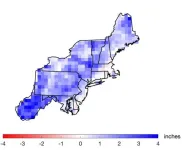(Press-News.org) Tiny foxes — each no bigger than a five-pound housecat — inhabiting the Channel Islands off the coast of Southern California were saved from extinction in 2016. However, new research reveals that the foxes now face a different threat to their survival.
Suzanne Edmands, professor of biological sciences at USC Dornsife College of Letters, Arts and Sciences, and Nicole Adams, who earned her PhD from USC Dornsife in 2019, found that the foxes’ genetic diversity has decreased over time, possibly jeopardizing their survival and the biodiversity of the islands.
“The findings of this study highlight the alarming fact that the foxes currently inhabiting six of the Channel Islands possess extremely low genetic diversity, rendering them potentially more susceptible to dangers such as disease outbreaks and climate-induced environmental shifts,” Edmands said.
As the largest native land animals on the islands located 22 miles off the coast of Southern California, these bushy-tailed, big-eared creatures play a vital role in regulating plant and animal communities by consuming various food sources, including fruit, insects, snails, lizards, birds, and rodents. In fact, many plant species rely on them to distribute seeds through their scat.
“The importance of these animals to the overall biodiversity of the island can’t be over-emphasized. Without them, we could lose other species as well,” Edmands said.
A previous study done in 2018 lacked sufficient sampling to detect changes in genetic variation. This new study used a broader sampling method, comparing historic museum specimens and modern blood samples.
The bushy-tailed, big-eared Channel Island Foxes play a vital role in regulating plant and animal communities. (Photo: by Karl Huggins.)
Interestingly, the results indicated extremely low genetic variation even before the population declines. It also revealed that the genetic variation had dropped even further since population numbers fell. The islands that experienced the most severe losses, San Miguel and Santa Rosa, also showed the greatest reduction in genetic diversity. Santa Cruz and Santa Catalina, two islands where populations fell moderately, displayed mixed changes in genetic diversity metrics.
Placing these island foxes on the endangered species list from 2004-16 played a crucial role in population recovery. By 2017 — a year after they were removed as an endangered species —the population on Catalina was found to have increased over that 13-year period from approximately 100 to more than 2,000, while Santa Rosa Island’s fox population rose from a low of 15 to more than 1200 over the same time span. However, their depleted genetic diversity continues to hinder the foxes’ ability to adapt to future challenges, such as global warming and introduced diseases.
While genetic variation is crucial for disease resistance and adaptation to climate change, the scientists did find one silver lining in their research. They found reasonably good diversity within the foxes’ gut microbiome, a key player in bolstering immunity and overall well-being.
“This discovery suggests that the foxes may have developed an alternative mechanism to cope with changing environmental conditions,” Edmands said.
The study also reveals an increased divergence between the six islands over time. This finding complicates the possible conservation strategy of moving foxes between islands to increase genetic variation. Such a move could inadvertently disrupt local adaptation by producing offspring that are less fit or not as well adapted to their specific environments. It should be noted that each island population is recognized as a separate endemic or unique subspecies.
Given their limited ability to respond to new challenges, long-term monitoring of the fox population is crucial. To that end, researchers have already started non-invasive monitoring by sequencing bacterial communities in the foxes’ scat.
“The recovery of fox population numbers is an incredible conservation success, but their fragile genetic condition means that continued vigilance is critical to ensure their survival,” Edmands said.
About the Study
The research was funded by The Offield Family Foundation and USC Dornsife and was published in Molecular Ecology.
END
Saved from extinction, Southern California’s Channel Island Foxes now face new threat to survival
Once threatened by disease and predators, foxes inhabiting six of Southern California’s Channel Islands were saved from extinction by the Endangered Species Act. Now, a new study shows they face a different threat: their own lack of genetic diversity.
2023-05-31
ELSE PRESS RELEASES FROM THIS DATE:
Genetic change increased bird flu severity during U.S. spread
2023-05-31
(MEMPHIS, Tenn. – May 29, 2023) St. Jude Children’s Research Hospital scientists discovered how the current epizootic H5N1 avian influenza virus (bird flu) gained new genes and greater virulence as it spread west. Researchers showed that the avian virus could severely infect the brains of mammalian research models, a notable departure from previous related strains of the virus. The researchers genetically traced the virus’ expansion across the continent and its establishment in wild waterfowl populations to understand what makes it so different. The study was recently published in Nature Communications.
“We ...
New Jersey Health Foundation awards grants to Kessler Foundation to advance research in brain and spinal cord stimulation methods
2023-05-30
East Hanover, NJ – May 30, 2023 – Annually, New Jersey Health Foundation (NJHF) invites researchers to submit applications for grants aimed at supporting pilot research projects that exhibit promising potential. These grants serve as opportunities for scientists to utilize their initial findings to secure further funding and progress their research. This year, NJHF granted awards to two Kessler Foundation scientists to conduct studies that expand research in upper extremity exercise after stroke ...
Extracting a clean fuel from water
2023-05-30
A plentiful supply of clean energy is lurking in plain sight. It is the hydrogen we can extract from water (H2O) using renewable energy. Scientists are seeking low-cost methods for producing clean hydrogen from water to replace fossil fuels, as part of the quest to combat climate change.
Hydrogen can power vehicles while emitting nothing but water. Hydrogen is also an important chemical for many industrial processes, most notably in steel making and ammonia production. Using cleaner hydrogen is highly desirable in those industries.
“By using ...
NJIT researchers awarded $4.6m to unlock mysteries of solar eruptions
2023-05-30
A New Jersey Institute of Technology research team led by physics professor Wenda Cao at the university’s Center for Solar Terrestrial Research (CSTR) has been awarded a $4.64 million National Science Foundation grant to continue leading explorations of the Sun’s explosive activity at Big Bear Solar Observatory (BBSO).
The grant marks the largest project that the Solar-Terrestrial Research Program under NSF’s Division of Atmospheric and Geospace Sciences (AGS) supports, extending five more years of baseline funding for all science, instrumentation and education activities at BBSO, located at California’s Big Bear Lake.
The ...
Extended lymph node removal does not benefit patients with clinically localized muscle-invasive bladder cancer
2023-05-30
An extended lymphadenectomy – removal of additional lymph nodes beyond the extent of the standard procedure – in patients undergoing radical cystectomy (removal of bladder and nearby tissues) because of clinically localized muscle-invasive bladder cancer provides no patient benefit as measured by disease-free survival or overall survival times. It does, however, increase the risk of adverse events (side effects) and post-surgical death.
These primary results from the phase 3 SWOG S1011 clinical ...
Study finds sex education tool improves reproductive health knowledge among adolescent girls
2023-05-30
HUNTINGTON, W.Va. – A Marshall University study found that a virtual sex education tool improved reproductive health knowledge scores and measures of self-efficacy among adolescent girls.
The findings, published last month in Sex Education, a leading international journal on sex, sexuality and relationships in education, found that sexual health knowledge scores on a validated scale increased among participants, along with improved measures of self-efficacy regarding birth control, healthy relationships and sexually transmitted infection (STI) prevention. Notably, ...
No-till revolution could stop Midwest topsoil loss in its tracks
2023-05-30
American Geophysical Union
25 May 2023
AGU Release No. 22
For Immediate Release
This press release and accompanying multimedia are available online at: https://news.agu.org/press-release/no-till-revolution-could-stop-midwest-topsoil-loss-in-its-tracks/
No-till revolution could stop Midwest topsoil loss in its tracks
If Midwestern farms all adopted low-intensity tilling practices or stopped tilling entirely, the erosion of critical topsoil could decrease by 95% in the next 100 years, new study finds
AGU press contact:
Rebecca ...
Computational method uncovers the effects of mutations in the noncoding genome
2023-05-30
Less than two percent of the human genome codes for proteins, with the rest being noncoding and likely helping with gene regulation. Mutations in the noncoding genome often trigger trait changes that cause disease or disability by altering gene expression. However, it can be hard for scientists to track down which of numerous variants associated with a disease or other complex trait are the causal ones and to understand the mechanism of their effects. Researchers at the Brigham developed a new computational approach that hones in on small regions of the noncoding genome that genome-wide association studies (GWAS) identified ...
Extreme precipitation in northeast to increase 52% by the end of the century
2023-05-30
With a warmer climate creating more humid conditions in the Northeast, extreme precipitation events — defined as about 1.5 or more inches of heavy rainfall or melted snowfall in a day — are projected to increase in the Northeast by 52% by the end of the century, according to a new Dartmouth study.
The findings are published in Climatic Change.
"As climate change brings warmer temperatures, you have more water vapor in the atmosphere, which creates the right conditions for extreme precipitation," says first author Christopher J. Picard '23, an earth sciences major and undergraduate researcher in the Applied Hydroclimatology Group ...
Lung infection may be less transmissible than thought
2023-05-30
A little-known bacterium — a distant cousin of the microbes that cause tuberculosis and leprosy — is emerging as a public health threat capable of causing severe lung infections among vulnerable populations, those with compromised immunity or reduced lung function.
Recent research found that various strains of the bacterium, Mycobacterium abscessus, were genetically similar, stoking fears that it was spreading from person to person.
But a new study by Harvard Medical School researchers published ...
LAST 30 PRESS RELEASES:
Why nail-biting, procrastination and other self-sabotaging behaviors are rooted in survival instincts
Regional variations in mechanical properties of porcine leptomeninges
Artificial empathy in therapy and healthcare: advancements in interpersonal interaction technologies
Why some brains switch gears more efficiently than others
UVA’s Jundong Li wins ICDM’S 2025 Tao Li Award for data mining, machine learning
UVA’s low-power, high-performance computer power player Mircea Stan earns National Academy of Inventors fellowship
Not playing by the rules: USU researcher explores filamentous algae dynamics in rivers
Do our body clocks influence our risk of dementia?
Anthropologists offer new evidence of bipedalism in long-debated fossil discovery
Safer receipt paper from wood
Dosage-sensitive genes suggest no whole-genome duplications in ancestral angiosperm
First ancient human herpesvirus genomes document their deep history with humans
Why Some Bacteria Survive Antibiotics and How to Stop Them - New study reveals that bacteria can survive antibiotic treatment through two fundamentally different “shutdown modes”
UCLA study links scar healing to dangerous placenta condition
CHANGE-seq-BE finds off-target changes in the genome from base editors
The Journal of Nuclear Medicine Ahead-of-Print Tip Sheet: January 2, 2026
Delayed or absent first dose of measles, mumps, and rubella vaccination
Trends in US preterm birth rates by household income and race and ethnicity
Study identifies potential biomarker linked to progression and brain inflammation in multiple sclerosis
Many mothers in Norway do not show up for postnatal check-ups
Researchers want to find out why quick clay is so unstable
Superradiant spins show teamwork at the quantum scale
Cleveland Clinic Research links tumor bacteria to immunotherapy resistance in head and neck cancer
First Editorial of 2026: Resisting AI slop
Joint ground- and space-based observations reveal Saturn-mass rogue planet
Inheritable genetic variant offers protection against blood cancer risk and progression
Pigs settled Pacific islands alongside early human voyagers
A Coral reef’s daily pulse reshapes microbes in surrounding waters
EAST Tokamak experiments exceed plasma density limit, offering new approach to fusion ignition
Groundbreaking discovery reveals Africa’s oldest cremation pyre and complex ritual practices
[Press-News.org] Saved from extinction, Southern California’s Channel Island Foxes now face new threat to survivalOnce threatened by disease and predators, foxes inhabiting six of Southern California’s Channel Islands were saved from extinction by the Endangered Species Act. Now, a new study shows they face a different threat: their own lack of genetic diversity.




